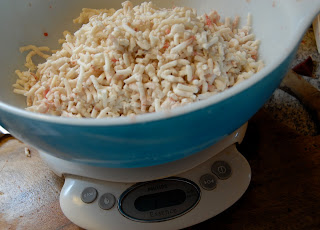A beautiful bison heart from an animal that spent its days roaming the prairie grasslands with its compadres. I sneak organ meat into our sausage with absolutely no noticeable difference in taste or texture.
I like to make my own sausage. I think they taste better, they're inexpensive to make, and I have complete control over what goes into them. I make a whack of them all at once and freeze them in containers of about 10 or so (that would be a serving around these parts). I was privy to some fine sausage making on one of my farming internships. I wouldn't dare think that my sausages are anywhere near as good, but they're pretty darn tasty (and healthy) for a home kitchen creation.
Grinding the heart with cubed round. Both meats are quite lean so the fat ratio has to be adjusted accordingly.
Start with pastured meat, whatever you have. The extent to how lean your meat is will determine the percentage of the fat you add. On this day, I was making two types of sausage. I had some ground pork that I had the farmer add enough fat to so that I could just mix it with spices and make sausage. If you purchase your meat directly from the farmer, request that trim and ground be mixed with fat in the ratio the butcher/farmer would use to make sausage. It may vary depending on the breed, genetics, diet of your animal. Having the meat already ground up makes sausage making as easy as adding in some spices and vegetables (or whatever you like). The other sausage I made was bison sausage. I decided to sneak a heart into the meat. I used bison tallow as my fat source for the bison sausage at a 20% ratio.
Weigh your meat and add 20% fat to start with. You can adjust this to your taste. Just fry up a little patty and see if you feel the sausage is too dry or needs the seasonings adjusted.
Unless the meat is ground for you with the required amount of fat already added, you will have to add some fat. The fat is important. You absolutely need fat from a pastured, organically raised animal. Toxins in an animal are stored in their fat. Animal fat from a conventionally raised animal is a concentrated source of hormones, antibiotics, pesticides, and various other chemicals. Just don't eat it. I try to stick with using fat and flesh sources from the same animal in my sausages, but there are times when that doesn't work out so well. With chicken sausage, I've found adding rendered pork fat compliments the poultry very well. You'll have to do a hunt for piggies raised without soy or grain (or at the least, very little), but it is possible.
Weighing out 20% bison tallow to add to the ground heart/round.
Sausage is our fast food around here. If we have to take off somewhere quickly, I throw a few sausages, still frozen, in a pan for 5 or 10 minutes, grab a jar of fermented veggies and we have a decent, quick meal. It's also a sneaky way to get some more organ meat into your family's diet. Organ meat is the highest natural source of vitamins A and D, and is loaded with many other vitamins and essential fatty acids. Pair good nutrition with delicious sausage and you just can't go wrong.
Regrind the meat with the fat. Add your spices and minced veggies if you're so inclined.
After you've ground the meat with the fat and added your spices, you have a few options. You can either use the sausage making attachment on your meat grinder to feed the mixture into casings or you can just keep it simple. I forego the casings and just flatten the sausage mixture on a parchment lined cookie sheet. I then put the cookie sheet in the freezer for half an hour. After that time, take out the cookie sheet and cut the sausage meat into sticks. Put the tray back in the freezer to solidly freeze the sticks. After an hour or so remove the cookie sheet and place the sausage sticks in containers for storage in the freezer. Freezing in this way prevents the meat from sticking together in a giant mound.
I like to use different recipes every time I make sausage. There are some great books available for spice ideas or just giving Google a quick peek turns up bazillions of suggestions. If all else fails, minced bacon with some fresh herbs, smoked salt and white pepper is a guaranteed sausage win.






No comments:
Post a Comment